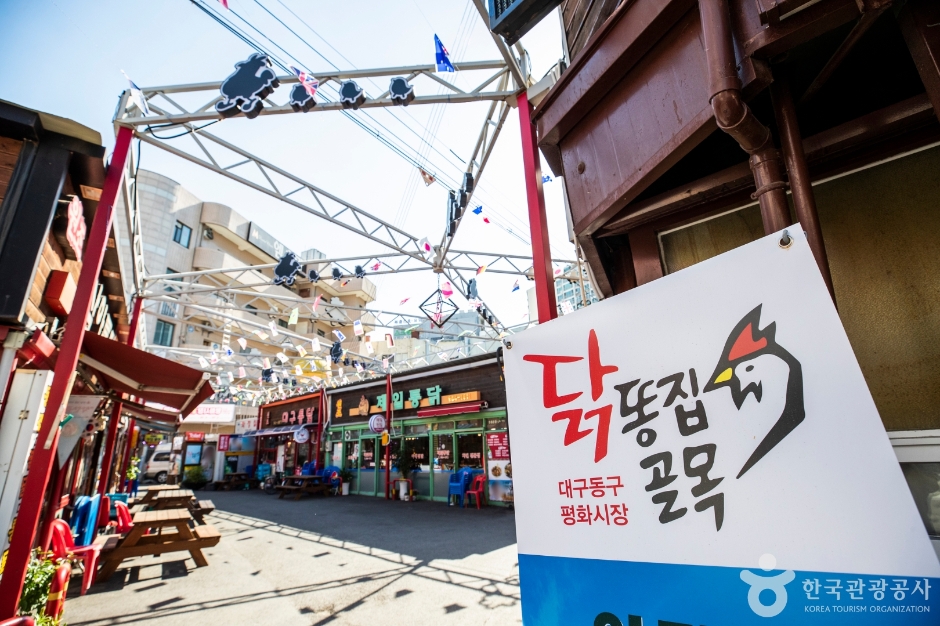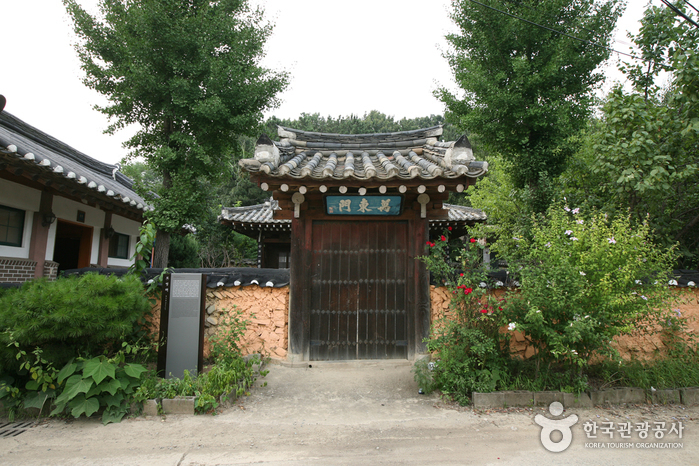Beanpole - Shinsegae Daegu Branch [Tax Refund Shop] (빈폴 신세계 대구점)
15.6Km 2024-04-23
149, Dongbu-ro, Dong-gu, Daegu
-
Galaxy Lifestyle - Shinsegae Daegu Branch [Tax Refund Shop] (갤럭시라이프스타일 신세계 대구점)
15.6Km 2024-04-18
149, Dongbu-ro, Dong-gu, Daegu
-
BVLGARI - Shinsegae Daegu Branch [Tax Refund Shop] (불가리 신세계 대구점)
15.6Km 2024-04-18
149, Dongbu-ro, Dong-gu, Daegu
-
Olive Young - Dongdaegu Station Branch [Tax Refund Shop] (올리브영 동대구지하철역점)
15.7Km 2024-06-27
B3 and B4, B 530, Dongdaegu-ro, Dong-gu, Daegu
-
E-Mart - Manchon Branch [Tax Refund Shop] (이마트 만촌)
15.8Km 2024-04-23
136, Dongwon-ro, Suseong-gu, Daegu
-
Pyounghwa Market Dakttongjip Street (대구 평화시장 닭똥집 골목)
15.8Km 2023-11-17
6 Ayang-ro 9-gil, Dong-gu, Daegu
+82-53-662-4072
Pyounghwa Market Dakttongjip Street was established with the opening of Samatongdak in 1972, and is a street specializing in chicken gizzard dishes. It is said that the dish was first offered as an affordable dish to accompany drinks, favored by blue-collar laborers who gathered at the early labor market in front of Pyounghwa Market in the 1970s. Inexpensive and delicious, the dish has remained popular.
Charmdaun Korean Medical Clinic (참다운 한의원)
16.0Km 2025-10-23
3rd Floor, Jasam Building, 50 Hwarang-ro, Suseong-gu, Daegu
Charmdaun Korean Medical Clinic, opened in 2017, is a Korean medicine clinic located in Suseong-gu, Daegu. It is led by a board-certified specialist in Korean gynecology (Doctor of Korean Medicine) and offers treatments such as anti-aging acupuncture, weight loss, constitutional diagnosis, women’s health care, and pain teatments (e.g., acupuncture, moxibustion).
Korean Traditional Culture Center (한국전통문화체험관)
16.3Km 2025-10-23
13-5 Dalgubeol-daero 527-gil, Suseong-gu, Daegu
+82-53-666-4930
Momyeongjae is an ancestral shrine built by the Dureung Doo clan to honor Doo Sa-chung, who had joined the Ming Dynasty's reinforcement troops during the Imjinwaeran (Japanese invasion of Korea, 1592) and later became naturalized in Joseon Dynasty. The name 'Momyeongjae' means 'longing for the Ming Dynasty,' expressing Doo Sa-chung's affection for his home country.
Doo Sa-chung, who was from Duling, China, went to Joseon under the command of General Li Rusong from the Ming Dynasty. Doo Sa-chung took the position titled Suryuk Jihoek Jusa and was responsible for selecting locations to establish a stronghold in consideration of the terrain. As a senior adviser to Li Rusong, he closely discussed strategies and tactics with the Joseon army as well.
When the war was over, Doo Sa-chung returned to China but went to Joseon again during the Jeongyujaeran (Japanese invasion of Korea, 1597). He brought his two sons -- Doo San and Doo Il-geon -- along with his brother-in-law, Admiral Chen Lin. When the war was over, Doo Sa-chung and his two sons naturalized in Joseon. The government of Joseon granted him land, which is the current Gyeongsang Gamyeong Park area.
When the Gyeongsang Gamyeong (Gyeongsang provincial office) was relocated to this area, Doo Sa-chung offered his land to the government and moved to Gyesan-dong.
Longing for his wife and brothers he had left in China, he moved again to a village near Daedeoksan Mountain (then Choejeongsan Mountain) and named the area Daemyeong-dong (meaning the Great Ming). He built a platform and on the first day of every month, he would bow in the direction of the Forbidden City in China, where the Emperor of the Ming Dynasty resided.
Momyeongjae is built on a rectangular plot and faces south. It features a hip-and-gable roof with double-layer eaves and has four rooms in the front and two rooms on the side. The daecheongmaru (wooden floor hall) has two ondol (floor heated) rooms on each of its side, with a half-sized bay at the front. Momyeongjae exemplifies the early 20th-century ancestral shrine style commonly found in the Daegu area.
The building was originally constructed in 1912 when Doo Sa-chung’s descendants moved wooden materials from the dismantled Gyeongsangaeksa (local government building) and used them to build Momyeongjae in front of Doo Sa-chung's tomb. The shrine was later renovated in 1966 as it was in poor condition.
Momyeongjae is one of the first destinations visited by Chinese tourists in Daegu. It was recently renovated as part of a redevelopment project. The Korean Traditional Culture Center opened nearby, where visitors can experience tea ceremonies, hanbok (traditional Korean clothing), archery, and cooking dishes based on Donguibogam, a traditional Korean medical encyclopedia. Joining a program at the center will be a valuable experience.
Benetton - Hyundai Department Store Daegu Branch [Tax Refund Shop] (베네통현대아울렛대구)
16.4Km 2024-04-23
454, Dongdaegu-ro, Dong-gu, Daegu
-
It Michaa - Hyundai Outlets Daegu Branch [Tax Refund Shop] (잇미샤 현대아울렛대구)
16.4Km 2024-04-22
454, Dongdaegu-ro, Dong-gu, Daegu
-
![Beanpole - Shinsegae Daegu Branch [Tax Refund Shop] (빈폴 신세계 대구점)](http://tong.visitkorea.or.kr/cms/resource/61/2883861_image2_1.jpg)
![Galaxy Lifestyle - Shinsegae Daegu Branch [Tax Refund Shop] (갤럭시라이프스타일 신세계 대구점)](http://tong.visitkorea.or.kr/cms/resource/62/2883862_image2_1.jpg)
![BVLGARI - Shinsegae Daegu Branch [Tax Refund Shop] (불가리 신세계 대구점)](http://tong.visitkorea.or.kr/cms/resource/66/2883866_image2_1.jpg)

![E-Mart - Manchon Branch [Tax Refund Shop] (이마트 만촌)](http://tong.visitkorea.or.kr/cms/resource/34/2884134_image2_1.jpg)


![Benetton - Hyundai Department Store Daegu Branch [Tax Refund Shop] (베네통현대아울렛대구)](http://tong.visitkorea.or.kr/cms/resource/96/2883896_image2_1.jpg)
![It Michaa - Hyundai Outlets Daegu Branch [Tax Refund Shop] (잇미샤 현대아울렛대구)](http://tong.visitkorea.or.kr/cms/resource/98/2883898_image2_1.jpg)
 English
English
 한국어
한국어 日本語
日本語 中文(简体)
中文(简体) Deutsch
Deutsch Français
Français Español
Español Русский
Русский